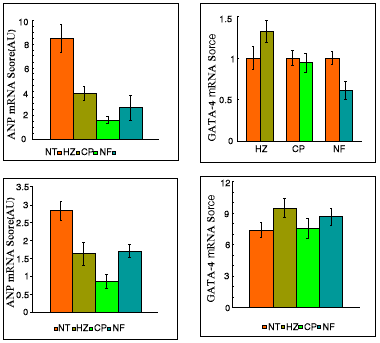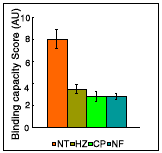

Spontaneously hypertensive rats (SHR) were grown to senescence (24 months) and changes in GATA-4 expression were evaluated in relation to the incease in blood pressure (BP) and heart weight. The major rise in BP occurrs in SHR between months 1-3 and a progressive gain in heart weight takes place throughout life, up to 24 months. GATA-4 mRNA increased with age particularly during the first 9 months suggesting that it may have a role in heart adaptation to increasing hemodynamic load. GATA-4 controls the transcription of many cardiac specific genes including ANP. Expression of both, GATA-4 and ANP was enhanced in SHR parallel to the rise in BP but the increase in expression was not fully coordinated, particularly at ages older than 12 months when a steep rise in ANP mRNA was not accompanied by a similar rise in GATA-4 mRNA (Fig. 1). Gel retardation assays of cardiac extracts assessed GATA-binding activity (function). A marked decline in GATA-activity was found after birth in normotensive as well as hypertensive rats which is, apparently, a developmental event. At any given age, however, SHR extracts manifested higher binding activity than extracts from age-matched normotensives (not shown). To better understand the relationship between GATA-4 and hypertension we treated SHRs with three antihypertensive drugs: a) hydralazine (HZ), a vasoconstrictor. b) captopril (CP), an ACE inhibitor. c) nifedipine (NF), a Ca++ channel antagonist. Treatments were given either at early stage of hypertension, between 3 and 6 months, or at advanced stage of the disease, between 15 and 18 months. In the two age groups, HZ and CP reduced BP to almost normotensive values whereas the effect of NF was marginal. While all three drugs reduced hypertrophy in the young, only CP regressed it in the old (not shown). The expression levels of ANP decreased with all three treatments in the two age groups (Fig 2). Analysis of the same RNA preparations for GATA-4 transcripts showed no reduction in GATA-4 expression in all treated SHR except for a moderate decrease in the NF-treated young rats (Fig 2). Assessment of GATA-binding activity revealed a reduction of GATA activity following all three treatments, although in the young rats the effect was much stronger (Fig. 3).
Taken together, our findings indicate that while the changes in ANP and GATA-4 mRNA are not coordinately regulated in hypertensive heart, modulation of GATA activity may have a role in ANP regulation, particularly its downregulation in antihypertensive treatments. It is suggested that enhancement or attenuation of GATA-dependent transcriptional activity may not be controlled by the availability of GATA mRNA but rather by the compatibility of the transcription complex. The identification of other proteins critical for GATA activation in the hypertensive heart requires additional research.
 |
 |
Figure 1: Age related changes in BP (left) and expression of GATA-4 and ANP (right) in SHR heart Figure 2: Effect of treatments on the levels of GATA-4 and ANP mRNA. Upper left, ANP mRNA, 3-to-6 mo. Lower left, ANP mRNA, 15-to-18 mo. Upper right, GATA-4 mRNA, 3-to-6 mo. Lower right, GATA-4 mRNA, 15-to-18 mo. NT, untreated rats, HZ, hydralazine; CP, captopril; NF, nifedipine; |
|
 |
 |
Figure 3: GATA binding activity in hearts of treated SHR. A, Representative gel retardation assays. Extracts from young SHR are on the left and from old SHR, on the right. B, Summary of multiple assays in treated young rats (3-to-6 mo). Symbols as above. |
|
